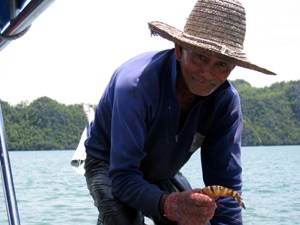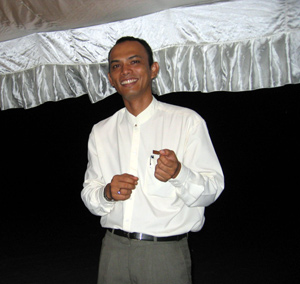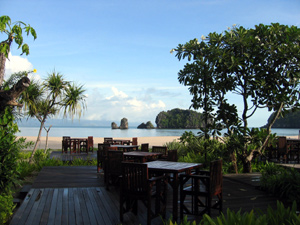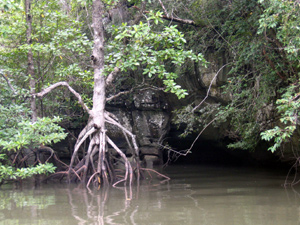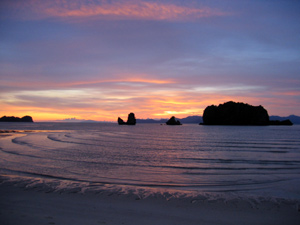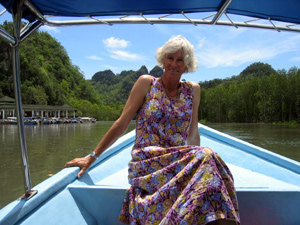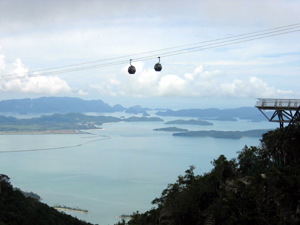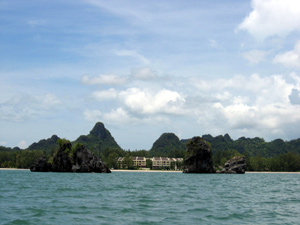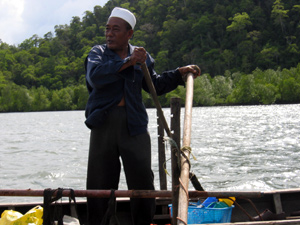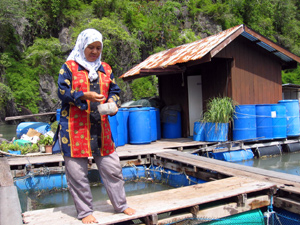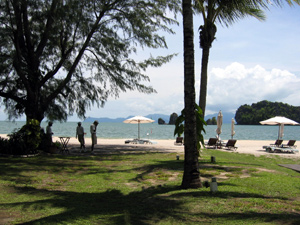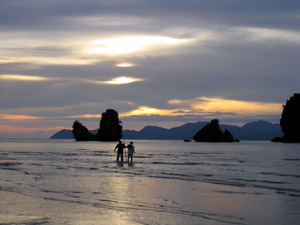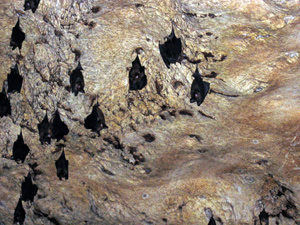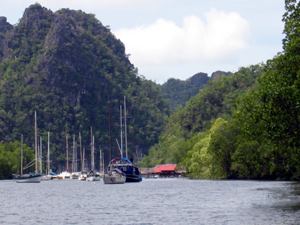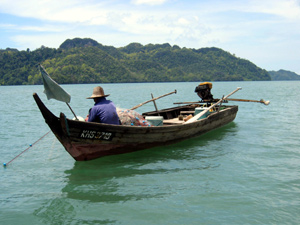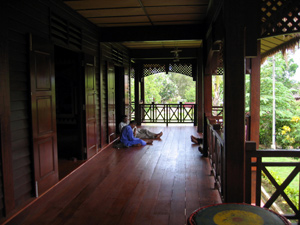
| |
|
|
Three days at the Tanjung Rhu resort, nestled in a small cove on the west
side of Langkawi Island. First class treatment, extroadinary beauty and
services at the resort, the amazing generosity of the hosts of the Edaran
Endurance Classic.
Langkawi (actually an archipelago of 99 isles) is the Island of the Eagle. 'Lang'- the Malaysian word for eagle, and 'Kawi' - the name that the island people give the the russet bodied eagle, with the white head and neck, 'Kawi' from the sound that it makes. Langkawi is located off the northwest coast of the Malay peninsula, just south of the Thailand border. Twenty five years ago there was no electricity on the island. Primarily native village people. Now there is a modern airport, several luxury resorts tucked into coves and along the beaches, and electricity and fresh water are piped 28 kilomters from the mainland in great conduits, 28 kilomters along the bottom of the Adaman Sea. There is still a quiet island feeling here, slow pace, no traffic or congestion. Small villages, rice paddies and rubber tree plantation. Brahma cattle grazing along the beach, in the fallow rice fields, or along grass lined country lanes. Rich tropical vegetation and rain forest. This is the start of the rainy season, so occasional showers punctuate the hot tropical days. I took a tour of the Island yesterday, visited a Batique center - artists creating original batique works on silk and cotton fabrics. My driver took me to the Heritage Center too - a complex built to display and preserve the Langkawi - Malaysian - heritage and culture. Stands where they made traditional foods, herbal medicines, a beatiful house - built of dark red wood (teak? mahogony?) with large verandas, tall ceilings, dark red wood floors - museum items and story lines . Legends abound in Malaysia, and Langkawi has it's own well-revered legend - The legend of Mahsuri - a young maiden falsely accused of adultery and sentenced to death. Her blood flowed white, proving her purity and innocence, and a 7 generation curse was placed on the island. The curse took hold of the island following the Siamese (Thailand) invasion in 1821 and the island receded into obscurity, succumbing to the curse. 7 generations later, in the mid 1980's Langkawi began again to flourish. Support and encouragement from the govermnent and Langkawi Development Authority nourished growing tourism industry soon, eventually turning Langkawi into a world-class tourist destination. The Tanjung Rhu is one of the finest resorts on Langkawa. Named from the land, Tanjung means cape, and Rhu is the native tree - long silver tamarisk-like needles. Langkawi is also know as ' Island of a thousand Legends'. The Tanjung Rhu resort (five star)is a 1100 acre complex, tucked into a loveley bay which protects it from the harsher currents and weather of the Adaman Sea, and offers a feeling of privacy and serenity. Complex walkways and water gardens, lush vegetation and flowering plants, garden benches hidden under palms and along stone pathways - and everything pointing towards the white sandy beach (the best natural sand beach on the island) in the crest of the bay. Blessed with a westerly exposure, the evenings at Tanjung Rhu are filled with the colors of the tropical sunset. Smaller islands and local fishing boats dot the horizon, and the mainland of Thailand can be seen across the sea. Estroardinary Malaysian hospitality here - three restuarants, the Rhu Health Spa (a traditional Malay massage can't be beat...), excursions, water sports, an incredible (and affordable by US$ standards) place. The most wonderful and relaxing place imaginable. I took the Magrove Excursion tour the first day here. Showed up at the beach center to meet the guide and skipper, and great fortune, I was the only tourist there for the tour. So a private guided tour (stretched from three hours to four hours) - special attention to the botanical and zoological wonders of the mangrove ecology, bat caves, eagle feeding, macaw monkeys, stop at a fish feeding station, tons of fun. The guide/naturalist was enthusiastic and offered all sorts of details on animal and plant life, and on the lives of the local fishermen. I'm sitting on the airplane as I write this (a familiar scenario?? :), looking out at the white puffy clouds building over the South China Sea. One stop in Taipei, and then to Los Angeles. And then back to Idaho. Still incredulous at having the opportunity to come to Malaysia(!!) for Endurance!! The opportunities that this sport offers seem to have no limit. Endurance is new enough that almost anybody can participate (from grooms to Sultans, clerks to millionaires, housewives to bankers, saddle makers to Sheikhs). There still doesn't exist the traditional class and economic barrier that other Equestrian sports have, especially at the level of International competition. And maybe since it's such a difficult and demanding sport, and the people that participate and support the challenge have a natural toughness and grit to begin with - maybe we will remain the 'sport of opportunity'. If you're tough enough, and horseman enough to understand the special demands of Endurance - on rider and equine alike, then have at it!
Photos of the Tanjung Rhu Resort
Mangrove Nature Tour - what a cool morning. This is the offseason on Langkawi, supposed to be the rainy season, but today was as perfect as it gets. Rain last night, cloudy early, clearing mid-morning - sunshine and comfortable temperatures. Visibility good - could see Thailand across the Adaman Sea. Left the beach with Zoher and the Skipper, I was the only person on the tour (Zohem said that was a first for him) so I got his full tour guide attention, and we stopped along the way for special, impulsive, diversions. Headed out on the bay, turned up X river channel. Went by some fishing shacks, floating shacks, pontoons, wood (mangrove) strips for walking. Men on fishing boats - fairly small, canoe-like, powered by oar and small engine. Can't afford real outboard engine, so the modify lawn mower engines. Use a long shaft to attach the propeller - since these engines have to remain vertical to work (not like the outboard engines) they need the long shaft so that the prop will reach the water. Mangroves - survive in salt water (90%saline here, small amount of fresh water from rivers, but mixed with tides) - special cells with osmotic pumps to absorb fresh water (science: water follows salt - the same for all living creatures - these trees have developed a system to move water against the salt, against the osmotic gradient)- Outer bark concentrates the salt, inner tissue remains isotonic to support life. Excess salt is forced out through leaf stomata, eventually the leaf will die and fall off. (there is a small fish here, which, like the flounder, is flat on top - it is colored exactly like a yellowed mangrove leaf, looks like a dead leaf floating on the water). The roots of the mangrove also have stomata (oxygen/water exchange) - long roots, some under water, some above. Also help stabilize the tree since it is rooted in soft muddy earth. The mangrove reproduce vegetatively - long 'fruit' like spears, with a developing leaf encased in a hard shell (protects it from hungry monkeys) - the 'fruit' drops, the long spear imbeds itself in the mud, the spear sprouts roots, and a new mangrove tree. (I planted one - will have to come back next year to see if it survived) There are virtually no mosquitoes here, very unusual (I've been to the Florida everglades and mangrove estuaries, lots of mosquitoes) - apparently this particular species of mangrove exudes a resin (response to insects, disease, etc) - the resin forms a coating over the estuarie water, and deters the mosquitoes from laying their eggs. Zomeh said, 'we have a real paradise here'. I think so. Went by an old charcoal kiln. The mangrove wood is very very dense and heavy(quickly sinks in the water). The kilns processed the wood into high grade charcoal for export (used for various filters). One bad guy on the island ran an illegal charcoal plant, harvested vast areas of mangrove but left a ring of live trees so that the 'clearcuts' weren't visible from the channels. Evenutally the estuaries got so muddy from the operation (no vegetation to stabilize it) that the fish started dissappearing, fishermen losing their livelihood. The culprit was discovered, all mangrove charcoal kilns on the island were shut down. Still are today, and the rivers and estuaries have now recovered. Eagles - we went by an area were they feed the eagles for the tourists. Beatiful birds, russet red - B... kites. When the problems in the estuaries developed because of the excessive harvesting of mangrove, the fish population suffered, and the eagles (which depended upon the fish for food) moved inland. They discovered the open fields along the Langkawi airport - the grassy strips offered great hunting for rodents, frogs, etc. Problem developed - the eagles hadn't lea\rned to avoid the aircraft, so to preserve the eagle, and move them away from the airport, the gov't started feeding them in the estuaries. Regular feeding sessions - it worked, they all moved back. But now they are dependent upon man, who in his great wisdom decided that it was too expensive to feed them fish, therefore they would feed them entrails from chicken processing. Ok feed, but now the birds are sharing parasites and disease from the poultry. New problems, next step... We rounded a man-made channel. Widened to allow small boat passage from one section of the island to another. Inland waterway. A natural harbor area. Boats from other parts of the world come here and harbor, maintained by the locals until the owners come back again for cruizes and island living. Nice harbor, quiet, scenic, a floating restaurant - fresh watered piped in from 4 km away. Perfect weather, no mosquitoes - an undiscovered paradise. Gorgeous dramatic limestone rock formations, trees (normal fresh water dependant trees) finding niches to survive, water from the rain, organic matter from decaying leaves, roots penetrating cracks in the limestone, 'searching' for more water - eventually creating fissures, more seedlings take hold, more organic matter, more life in the rocks. Went to a fish farm, raising fish and mussels. Set up for tourists also - small netted areas, deep water (4 meters) with various species - snappers, baracudas, a few others whose names I didn't recognize. The wife helped feed the fish so I could see them come to the surface. She had two stingrays in one pool, male and female, both had been named by a previous Japanese tourist, and now they were her pets, not for sale, not for harvest. Headed back towards the bay now, opening up. Stopped at an amazing limestone cave, inhabited by bats, stalagtites, stalagmites, roots from the trees above growing down into the water at the bottom of the cave (only to be dissappointed by the salt water!) On the way we passed a rock outcrop with a group of mackaw ? monkeys sunning themselves, very tame - no fear. Allowed close photos. Mothers clutching their wet babies, one scar-faced male keeping an eye on things. Next to the bat cave - so very cool! Bats clinging by one foot to the cave roof during the day (every once in a while they let go, flew in a circle and latched back on with the other foot). Beautiful sculptures of roots and stone, dripping sounds, water oozing and gurgling below as the tide was slowing rising. Zomeh showed me a special leaf - he carefully plucked it off of it's stem and a white sap extruded - he said 'this will blind you if it touches your eye'. It looked pretty nasty, I believed him. 'But if you ever find yourself abandoned in the mangrove it can also save your life. If you put some of the sap on your hand and lower it into the water, it will diffuse into a toxic soup that will stun all the fish around you in a wide radius. Fish for the picking, fish for survival. But - if too much of the toxin penetrates the fish it will make you very sick, so then you can eat this leaf (pointing to a small green waxy leaf) and it will cure you'. There was a friend of his, another tour guide I think, standing next to us. Zomeh said there are people here who know all of the secrets of the rainforest, many plants, many poisons and medicines. He gestured toward his friend - 'this man is a 'sombo' - a Malaysian medicine man' . The sombo nodded wisely. We headed out of the channels onto the sea - the Adaman Sea. Thailand was visible across the water - hazy blue Islands. Thailand! We came upon a small boat along one of the dozens of small islands on the way back to Tanjung Rho. A lone man, pulling in his fishing nets - brown, wrinkled, small - I really felt like we were in Asia! We pulled up close and watched him, he showed us his catch. Some squid, grouper, and one grand prawn that he pulled out of the net.
Back to the resort, the Skipper opened up our little boat, wind and spray,
bouncing along the waves. Perfect day - a fantastic tour.
|
